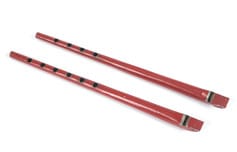Presented by Museum of the Peace Corps Experience and American University Museum
Mid-twentieth century
Northern Sierra, Ecuador
Tin, red paint, 1/2 x 12 x 1/2 in. each
Collection, Museum of the Peace Corps Experience
Gift of Anne Bluemel, Ecuador, Cayambe 1976–78

One of the most valuable lessons I learned during my Peace Corps years was that people who endure the worst that life brings them will try to take time away from their day-to-day struggles to enjoy a little merrymaking. Parades, parties, religious processions, celebrations, and performances in homes with family and friends offered occasions for music. Instruments included guitars, panpipes, flutes, and drums. The sounds varied with the people who were playing, whether they were indigenous, low income, upper society, youth, elderly, or from different parts of the country.
The men in my adopted family were the primary musicians, playing mostly guitars, but they knew a lot of the Ecuadorean songs and music. Traditional music included pasillos, which told of hardships and lost love.
A close Ecuadorean friend gave me two rare tin flutes and told me a story that partially explains why I never heard or saw these instruments being played.
Traditionally both flutes were played simultaneously in the mouth of one musician who fingered holes separately with each hand. Sometimes other instruments would accompany the flutes on melancholy songs about heartaches, unbearable living conditions, and harsh treatment of campesinos (peasants). Occasionally while music was playing, people said they were “provoked” into drinking aguardiente (firewater)—a drink typical in the Sierras, with 40 to 60 percent alcohol content.
I asked why the flutes were never played in public and heard an explanation that I cannot verify: I was told that more than 30 years earlier, in the 1940s, flutes were banished by the government because the sad music had prompted too many suicides. It seems more likely that over many generations, the difficult skill of playing two flutes simultaneously stopped being passed down, except to a tiny number of musicians.
I’m content to let the mystery of Ecuador’s rare tin flutes remain unsolved. They remind me that some people may fall into despair, but others enjoy music as a small respite from their daily struggles.
Museum of the Peace Corps Experience
PO Box 2427
Oregon City, OR 97045
USA
The Committee for a Museum of the Peace Corps Experience is a 501(c)(3) private nonprofit organization. Tax ID: EIN # 93-1289853
The Museum is not affiliated with the U.S. Peace Corps and not acting on behalf of the U.S. Peace Corps.
Museum of the Peace Corps Experience © 2024. All Rights Reserved.